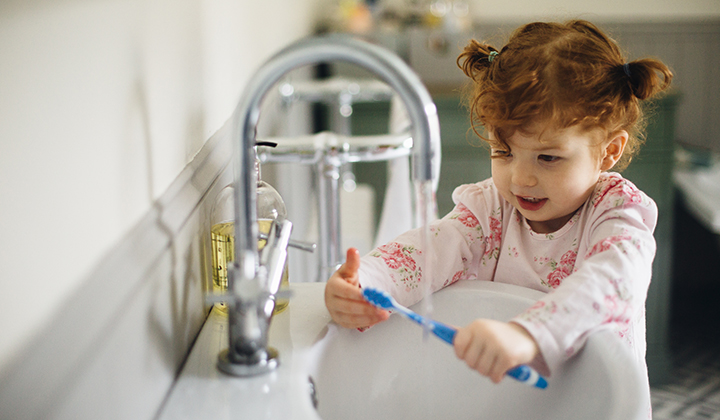Get updates
Have a parenting hack to share? Or a topic you'd like to see?
How to keep brushing your teeth fun

We all know getting your kids to brush their teeth can be a struggle. Despite how challenging it can be, brushing your teeth is an essential part of everyone’s morning and nighttime routine. Telling your kids not brushing their teeth will make their teeth fall out may be the truth, but it won’t help those kids who struggle with this mundane, everyday task. Keep reading our guide for ways to add some fun into your teeth brushing routine!
Prefer to listen? Check out our podcast episode on teeth brushing here, or wherever you listen to podcasts!
What each age group needs for dental health
0-6 months. In the first months of your child’s life, before they even have teeth, run your finger across their gums the way you would a toothbrush. Getting them used to having things in their mouth and close to their gums from an early age will help create a sense of familiarity with brushing their teeth as they continue to grow.
6 months–7 years old. Parents should be brushing their child’s teeth and flossing for them until they are around 7 years old. When your child can start brushing their own teeth depends on their ability.
7-9 years old. Until they are 9 years old, parents should watch their kids brush and floss their teeth to make sure they are getting everywhere they need to.
9 years old and older. Once a child turns 9 years old, they should be able to brush and floss their teeth on their own with no help from parents. This does depend on the child, so before leaving your child with free reign while brushing their teeth, make sure they’re ready for it.
Tips and tricks to keep your kids entertained while brushing their teeth
It can be a battle to get your toddler to open up to let you brush their teeth or to get your middle schooler to actually brush twice a day. We feel your struggle, but there are things you can try at home to keep your kids entertained while they brush their teeth.
- Have your younger kids make animal noises to show their teeth while you brush them.
- Use floss sticks to make flossing easier and more fun.
- Ask your kids which side they want to brush first so they feel like they have choice in brushing their teeth.
- Have multiple toothbrushes they can pick from every time they brush their teeth. The toothbrush can be manual or electric, as long as it’s soft-bristled.
- Tell them the tooth fairy can only accept clean teeth.
- Brush your teeth with your kids or have an older sibling model for them. Show them how it’s done!
- Have a special toy/stuffed animal with its own toothbrush, so your child can brush its teeth before or after brushing their own.
- Turn on a 2-minute video for them to watch while brushing.
- Listen to music or come up with a special song your family sings while brushing teeth.
- Use a sticker/reward chart. After they’ve brushed their teeth a certain number of times, they receive a special prize.
Dental health facts to remember as your kids grow
Along with these tips and tricks, there are a few dental hygiene facts that are important for parents to know:
- Babies should not go to bed with a bottle of milk. If they do, make sure to wipe off their teeth afterwards.
- If your child has teeth that touch, they need to be flossed.
- Children should have all their teeth by age 3. If you haven’t incorporated flossing yet, this is the age to do so.
- Kids will not typically like cinnamon or mint flavored toothpaste; look for bubblegum or fruity flavors if your child is struggling with toothpaste. If they don’t like toothpaste, still brush! Just the act of brushing helps remove food and deposits from the teeth.
- Fluoride toothpaste is appropriate to use as long as it is in the proper amount; for children under 3 years this is a smear, for 3-6 years, a pea size amount.
- If your child’s gums bleed when they brush, that means the gums aren’t healthy. They will bleed a couple of days while flossing until they are healthy again.
- Along with brushing teeth, your child should be brushing their gums. Lift their upper lip to make sure they brush up to the gum, gently rubbing at a 45-degree angle in a circular motion.
- Decay is preventable! Brushing your teeth is the biggest way to prevent decay along with good nutrition.
- Your child should start seeing a dental provider by age 1, or 6 months after their first tooth erupts. Don’t wait until you see a problem.
Ultimately, to keep brushing their teeth fun for your kids, it starts with turning it into a routine they are used to. Starting dental hygiene from a young age will not only help keep your child’s teeth clean but also help them to start that routine early.

